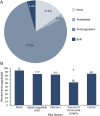Treatment and outcome of childhood cerebral sinovenous thrombosis
- PMID: 32642325
- PMCID: PMC7292564
- DOI: 10.1212/CPJ.0000000000000720
Treatment and outcome of childhood cerebral sinovenous thrombosis
Abstract
Objective: To test our hypothesis that anticoagulation is associated with better neurologic outcomes in childhood cerebral sinovenous thrombosis (CSVT), we analyzed treatment and outcomes in a population of 410 children from the International Pediatric Stroke Study (IPSS).
Methods: We included patients enrolled in the IPSS registry with a diagnosis of CSVT at age >28 days with radiologic confirmation, in isolation or with concomitant arterial ischemic stroke. The primary outcome was the neurologic status at discharge. We defined unfavorable outcome as severe neurologic impairment or death at discharge. The Pediatric Stroke Outcome Measure was used for long-term outcome in those with follow-up. Predictors of anticoagulation use and outcome were analyzed by logistic regression.
Results: Most children (95%) had identifiable risk factors, and 82% received anticoagulation. Shift analysis demonstrated better outcomes at discharge in children who were anticoagulated, and this persisted with longer-term outcomes. In multivariable analysis, anticoagulation was significantly associated with favorable outcomes (adjusted odds ratio [aOR] unfavorable 0.32, p = 0.007) whereas infarct was associated with unfavorable outcome (aOR unfavorable 6.71, p < 0.001). The trauma/intracranial surgery was associated with a lower odds of anticoagulation use (aOR 0.14, p < 0.001).
Conclusions: Within the IPSS registry, children with risk factors of trauma or intracranial surgery were less likely to receive anticoagulation for CSVT. Anticoagulation was associated with a lower odds of severe neurologic impairment or death at hospital discharge, but this finding is limited and needs further confirmation in randomized, controlled, prospective studies.
© 2019 American Academy of Neurology.
Figures




References
-
- Einhaupl KM, Villringer A, Meister W, et al. . Heparin treatment in sinus venous thrombosis. Lancet 1991;338:597–600. - PubMed
-
- Einhaupl K, Stam J, Bousser MG, et al. . EFNS guideline on the treatment of cerebral venous and sinus thrombosis in adult patients. Eur J Neurol 2010;17:1229–1235. - PubMed
-
- Saposnik G, Barinagarrementeria F, Brown RD Jr, et al. . Diagnosis and management of cerebral venous thrombosis: a statement for healthcare professionals from the American Heart Association/American Stroke Association. Stroke 2011;42:1158–1192. - PubMed
-
- Moharir MD, Shroff M, Stephens D, et al. . Anticoagulants in pediatric cerebral sinovenous thrombosis: a safety and outcome study. Ann Neurol 2010;67:590–599. - PubMed
Grants and funding
LinkOut - more resources
Full Text Sources
